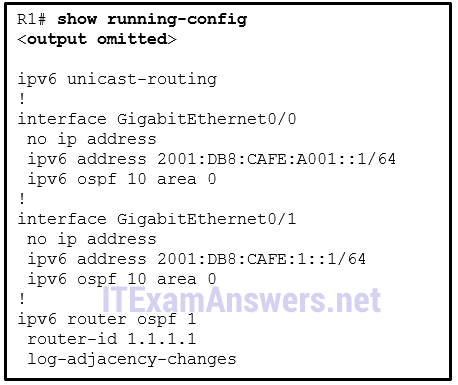Refer to the exhibit. Directly connected networks configured on router R1 are not being shared with neighboring routers through OSPFv3. What is the cause of the issue?

- There are no network statements for the routes in the OSPF configuration.
- The no shutdown command is missing on the interfaces.
- IPv6 OSPF routing is not enabled.
- There is a mismatch of OSPF process ID in commands.
Explanation: Unlike OSPFv2, OSPFV3 does not use the network command to advertise directly attached networks. OSPFv3 is enabled directly on the interface. These networks will be included in advertisements once the command ipv6 ospf process_id area area_id is entered on the interface. The OSPF process_id must match with the ipv6 router ospf command.
Other case:
- IPv6 OSPF routing is not enabled.
- The routes are not enabled in the OSPF advertisement.
- There are no IPv4 addresses configured on the interfaces.
- There are no network statements for the routes in the OSPF configuration.
Explanation: Unlike OSPFv2, OSPFV3 does not use the network command to advertise directly attached networks. OSPFv3 is enabled directly on the interface. Once the command ipv6 ospf process_id area area_id is entered on the interface, that particular network will be included in OSPFv3 advertisements.
Exam with this question: CCNA 3 (v5.0.3 + v6.0) Chapter 10 Exam Answers
Exam with this question: CCNP ENARSI 8 Modules 6 - 10 Checkpoint Exam: OSPF Exam
Exam with this question: CCNP ENARSI v8 Certification Practice Exam
Please login or Register to submit your answer
